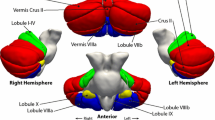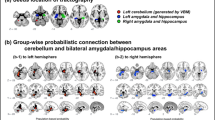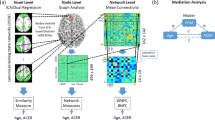Abstract
Although recently conceptualized as a neural node essential for a vast spectrum of associative and cognitive processes, the cerebellum has largely eluded attention in the research of aging, where it is marginalized mainly to structural analyses. In the current cross-sectional study of 67 healthy subjects of various ages (20 to 76 years), we sought to provide a comprehensive, multimodal account of age-related changes in the cerebellum during predictive motor timing, which was previously shown to engage this structure. We combined behavioral assessments of performance with functional MRI and voxel-based morphometry using an advanced method to avoid cerebellar deformation and registration imprecisions inherent to the standard processing at the whole-brain level. Higher age was surprisingly associated with stable behavioral performance during predictive motor timing, despite the massive decrease of infratentorial gray matter volume of a far higher extent than in the supratentorial region, affecting mainly the posterior cerebellar lobe. Nonetheless, this very area showed extensive hyperactivation directly correlated with age. The same region had decreased connectivity with the left caudate and increased connectivity with the left fusiform gyrus, the right pallidum, the hippocampus, and the lingual gyrus. Hence, we propose to extend the scaffolding theory of aging, previously limited mainly to the frontal cortices, to include also the cerebellum, which is likewise suffering from atrophy to a far greater extent than the rest of the brain and is similarly counteracting it by bilateral hyperactivation.




Similar content being viewed by others
Abbreviations
- MRI:
-
Magnetic resonance imaging
- fMRI:
-
Functional magnetic resonance imaging
- VBM:
-
Voxel-based morphometry
- BOLD:
-
Blood-oxygen-level dependent
References
Seidler RD, Bernard JA, Burutolu TB, Fling BW, Gordon MT, Gwin JT, et al. Motor control and aging: links to age-related brain structural, functional, and biochemical effects. Neurosci Biobehav Rev. 2010;34(5):721–33.
Salthouse TA. Selective review of cognitive aging. J Int Neuropsychol Soc. 2010;16(5):754–60.
Harper S. Economic and social implications of aging societies. Science. 2014;346(6209):587–91.
Naccarato M, Calautti C, Jones PS, Day DJ, Carpenter TA, Baron JC. Does healthy aging affect the hemispheric activation balance during paced index-to-thumb opposition task? An fMRI study. Neuroimage. 2006;32(3):1250–6.
Mattay VS, Fera F, Tessitore A, Hariri AR, Das S, Callicott JH, et al. Neurophysiological correlates of age-related changes in human motor function. Neurology. 2002;58(4):630–5. https://doi.org/10.1212/WNL.58.4.630.
Stoodley CJ, Schmahmann JD. Functional topography in the human cerebellum: a meta-analysis of neuroimaging studies. Neuroimage. 2009;44(2):489–501.
Filip P, Lungu OV, Manto M-U, Bareš M. Linking essential tremor to the cerebellum: physiological evidence. Cerebellum. 2016;15(6):774–80.
Marcián V, Filip P, Bareš M, Brázdil M. Cerebellar dysfunction and Ataxia in patients with epilepsy: coincidence, consequence, or cause? Tremor Hyperkinetic Mov. 2016;6:376. https://doi.org/10.7916/D8KH0NBT.
Bernard JA, Seidler RD. Moving forward: age effects on the cerebellum underlie cognitive and motor declines. Neurosci Biobehav Rev. 2014;42:193–207.
Raz N, Gunning-Dixon F, Head D, Williamson A, Acker JD. Age and sex differences in the cerebellum and the ventral pons: a prospective MR study of healthy adults. Am J Neuroradiol. 2001;22(6):1161–7.
Tang Y, Whitman GT, Lopez I, Baloh RW. Brain volume changes on longitudinal magnetic resonance imaging in normal older people. J Neuroimaging. 2001;11(4):393–400. https://doi.org/10.1111/j.1552-6569.2001.tb00068.x.
Bernard JA, Seidler RD. Relationships between regional cerebellar volume and sensorimotor and cognitive function in young and older adults. Cerebellum. 2013;12(5):721–37. https://doi.org/10.1007/s12311-013-0481-z.
Bernard JA, Peltier SJ, Wiggins JL, Jaeggi SM, Buschkuehl M, Fling BW, et al. Disrupted cortico-cerebellar connectivity in older adults. NeuroImage. 2013;83:103–19. https://doi.org/10.1016/j.neuroimage.2013.06.042.
Ferreira LK, Busatto GF. Resting-state functional connectivity in normal brain aging. Neurosci Biobehav Rev. 2013;37(3):384–400. https://doi.org/10.1016/j.neubiorev.2013.01.017.
Tian L, Ma L, Wang L. Alterations of functional connectivities from early to middle adulthood: clues from multivariate pattern analysis of resting-state fMRI data. NeuroImage. 2016;129:389–400. https://doi.org/10.1016/j.neuroimage.2016.01.039.
Filip P, Lošák J, Kašpárek T, Vaníček J, Bareš M. Neural network of predictive motor timing in the context of gender differences. Neural Plast. 2016;2016:1–9.
Filip P, Gallea C, Lehéricy S, Bertasi E, Popa T, Mareček R, et al. Disruption in cerebellar and basal ganglia networks during a visuospatial task in cervical dystonia. Mov Disord. 2017;32(5):757–68.
Husárová I, Mikl M, Lungu OV, Mareček R, Vaníček J, Bareš M. Similar circuits but different connectivity patterns between the cerebellum, basal ganglia, and supplementary motor area in early Parkinson’s disease patients and controls during predictive motor timing. J Neuroimaging. 2013;23(4):452–62.
Schmahmann JD, Sherman JC. The cerebellar cognitive affective syndrome. Brain J Neurol. 1998;121(4):561–79.
Diedrichsen J, Balsters JH, Flavell J, Cussans E, Ramnani N. A probabilistic MR atlas of the human cerebellum. NeuroImage. 2009;46(1):39–46. https://doi.org/10.1016/j.neuroimage.2009.01.045.
Diedrichsen J. A spatially unbiased atlas template of the human cerebellum. NeuroImage. 2006;33(1):127–38. https://doi.org/10.1016/j.neuroimage.2006.05.056.
Oldfield RC. The assessment and analysis of handedness: the Edinburgh inventory. Neuropsychologia. 1971;9(1):97–113.
Bares M, Lungu OV, Liu T, Waechter T, Gomez CM, Ashe J. The neural substrate of predictive motor timing in spinocerebellar ataxia. Cerebellum. 2011;10(2):233–44. https://doi.org/10.1007/s12311-010-0237-y.
Filip P, Lungu OV, Shaw DJ, Kasparek T, Bareš M. The mechanisms of movement control and time estimation in cervical dystonia patients. Neural Plast. 2013;2013:1–10.
Predictive motor timing and the cerebellar vermis in schizophrenia: an fMRI study | Schizophr Bull | Oxford Academic. https://academic.oup.com/schizophreniabulletin/article/42/6/1517/2399483. Accessed January 16, 2019.
Schuirmann DJ. A comparison of the two one-sided tests procedure and the power approach for assessing the equivalence of average bioavailability. J Pharmacokinet Biopharm. 1987;15(6):657–80.
Bares M, Lungu O, Liu T, Waechter T, Gomez CM, Ashe J. Impaired predictive motor timing in patients with cerebellar disorders. Exp Brain Res Exp. 2007;180(2):355–65.
Friston KJ, Buechel C, Fink GR, Morris J, Rolls E, Dolan RJ. Psychophysiological and modulatory interactions in neuroimaging. Neuroimage. 1997;6(3):218–29.
Eickhoff SB, Stephan KE, Mohlberg H, Grefkes C, Fink GR, Amunts K, et al. A new SPM toolbox for combining probabilistic cytoarchitectonic maps and functional imaging data. Neuroimage. 2005;25(4):1325–35.
Tzourio-Mazoyer N, Landeau B, Papathanassiou D, Crivello F, Etard O, Delcroix N, et al. Automated anatomical labeling of activations in SPM using a macroscopic anatomical parcellation of the MNI MRI single-subject brain. Neuroimage. 2002;15(1):273–89.
Wu T, Hallett M. The influence of normal human ageing on automatic movements. J Physiol. 2005;562(2):605–15. https://doi.org/10.1113/jphysiol.2004.076042.
Welford AT, Norris AH, Shock NW. Speed and accuracy of movement and their changes with age. Acta Psychol. 1969;30(C):3–15.
Jernigan TL, Archibald SL, Fennema-Notestine C, Gamst AC, Stout JC, Bonner J, et al. Effects of age on tissues and regions of the cerebrum and cerebellum. Neurobiol Aging. 2001;22(4):581–94. https://doi.org/10.1016/S0197-4580(01)00217-2.
Walhovd KB, Fjell AM, Reinvang I, Lundervold A, Dale AM, Eilertsen DE, et al. Effects of age on volumes of cortex, white matter and subcortical structures. Neurobiol Aging. 2005;26(9):1261–70. https://doi.org/10.1016/j.neurobiolaging.2005.05.020.
Sullivan EV, Deshmukh A, Desmond JE, Lim KO, Pfefferbaum A. Cerebellar volume decline in normal aging, alcoholism, and Korsakoff’s syndrome: relation to ataxia. Neuropsychology. 2000;14(3):341–52. https://doi.org/10.1037//0894-4105.14.3.341.
Stoodley CJ. The cerebellum and cognition: evidence from functional imaging studies. Cerebellum. 2012;11(2):352–65.
Cabeza R. Hemispheric asymmetry reduction in older adults: the HAROLD model. Psychol Aging. 2002;17(1):85–100.
Ward NS, Frackowiak RSJ. Age-related changes in the neural correlates of motor performance. Brain J Neurol. 2003;126(0 4):873–88.
Taniwaki T, Okayama A, Yoshiura T, Togao O, Nakamura Y, Yamasaki T, et al. Age-related alterations of the functional interactions within the basal ganglia and cerebellar motor loops in vivo. NeuroImage. 2007;36(4):1263–76. https://doi.org/10.1016/j.neuroimage.2007.04.027.
Bo J, Peltier SJ, Noll DC, Seidler RD. Age differences in symbolic representations of motor sequence learning. Neurosci Lett. 2011;504(1):68–72. https://doi.org/10.1016/j.neulet.2011.08.060.
Driver J, Spence C. Multisensory perception: beyond modularity and convergence. Curr Biol. 2000;10(20):R731–5.
Schroeter ML, Zysset S, Kruggel F, Von Cramon DY. Age dependency of the hemodynamic response as measured by functional near-infrared spectroscopy. Neuroimage. 2003;19(3):555–64.
Huettel SA, Singerman JD, McCarthy G. The effects of aging upon the hemodynamic response measured by functional MRI. Neuroimage. 2001;13(1):161–75.
Park DC, Reuter-Lorenz P. The adaptive brain: aging and neurocognitive scaffolding. Annu Rev Psychol. 2009;60:173–96.
De Zeeuw CI, Ten Brinke MM. Motor learning and the cerebellum. Cold Spring Harb Perspect Biol. 2015;7(9):a021683.
Buckner RL, Krienen FM, Castellanos A, Diaz JC, Yeo BT. The organization of the human cerebellum estimated by intrinsic functional connectivity. J Neurophysiol. 2011;106(5):2322–45.
Acknowledgments
The authors are grateful to the patients and their families for their support of this research.
Funding
This work was supported by the EU H2020 Marie Skłodowska RISE project #691110 (MICROBRADAM).
Author information
Authors and Affiliations
Corresponding author
Ethics declarations
The study was approved by the Institutional Review Board of the University Hospital of St. Anne (Brno, Czech Republic) and by the Institutional Review Board of the University of Minnesota (Minneapolis, USA).
Conflict of Interests
There are no potential conflicts of interests regarding this paper and no financial or personal relationships that might bias this work.
Additional information
Publisher’s Note
Springer Nature remains neutral with regard to jurisdictional claims in published maps and institutional affiliations.
Rights and permissions
About this article
Cite this article
Filip, P., Gallea, C., Lehéricy, S. et al. Neural Scaffolding as the Foundation for Stable Performance of Aging Cerebellum. Cerebellum 18, 500–510 (2019). https://doi.org/10.1007/s12311-019-01015-7
Published:
Issue Date:
DOI: https://doi.org/10.1007/s12311-019-01015-7




